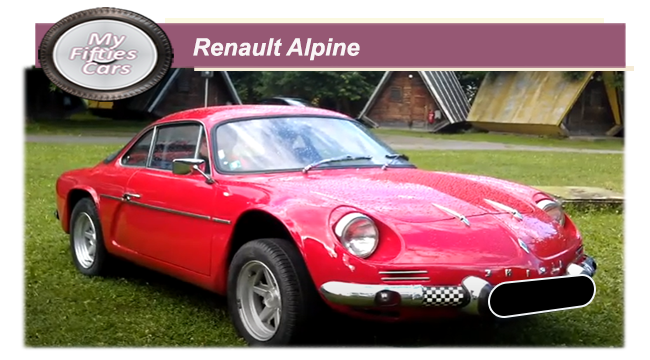 The Société des Automobiles Alpine SAS, trading under the Alpine marque , was founded in the French city of Dieppe in 1955 by Jean Rédélé to produce both track and production sports cars.
The Société des Automobiles Alpine SAS, trading under the Alpine marque , was founded in the French city of Dieppe in 1955 by Jean Rédélé to produce both track and production sports cars.
Rédélé, became a familiar figure in round the race tracks of Europe in the immediate post war years, developed his own race car based closely on the Renault 4CV.
 Driving his adapted 4CV, Rédélé brought home a number of trophies in his class, among them the Mille Miglia and Coupe des Alpes. With each success, Rédélé continued to modify the 4CV, adding a custom design five-speed gearbox as well as a series of specially produced lightweight aluminium bodies.
Driving his adapted 4CV, Rédélé brought home a number of trophies in his class, among them the Mille Miglia and Coupe des Alpes. With each success, Rédélé continued to modify the 4CV, adding a custom design five-speed gearbox as well as a series of specially produced lightweight aluminium bodies.
Encouraged by the development of these cars and consequent customer demand, he created the Alpine brand in 1954, after Rédélé’s Coupe des Alpes successes,
![]()
 In 1955, Rédélé combined forces with the Paris based coachbuilder Chappe et Gessalin to be amongst the pioneers of auto glass fibre construction. Their collaboration brought about the release of the company’s first production car, the Alpine A106.
In 1955, Rédélé combined forces with the Paris based coachbuilder Chappe et Gessalin to be amongst the pioneers of auto glass fibre construction. Their collaboration brought about the release of the company’s first production car, the Alpine A106.
 Alpine several successes through the 1950s and was joined by a low and stylish cabriolet. Styling for this car was contracted to the Italian designer Giovanni Michelotti. Under the glass fibre body was a very stiff chassis based on a central tubular backbone which was to be the hallmark of all Alpines.
Alpine several successes through the 1950s and was joined by a low and stylish cabriolet. Styling for this car was contracted to the Italian designer Giovanni Michelotti. Under the glass fibre body was a very stiff chassis based on a central tubular backbone which was to be the hallmark of all Alpines.
Initially built for racing, in 1956, the A106 was released as a production car at the Paris Motor Show in 1957, Interest was high and sales encouraging leading to the eventual launch of a sports coupé, convertible and cabriolet version.
In 1958 Alpine announced the launch of the A108 ‘Berlinetta’. The A108 went on to become among the most prolific winners on the international rally circuit during the late Fifties and early Sixties. The A108, +2 closed coupe, based closely on Michelotti’s cabriolet design was powered by the 845 cc engine used on the Dauphine Gordini. Later engines were bored out to a capacity of 998 cc. The A108 remained in production till 1963.
![]()
 Real top-level success started in 1968 with outright wins in the Coupe des Alpes and other international events. By this time the competition cars were fitted with 1440 cc engines derived from the Renault R8 Gordini.
In 1962, Alpine announced the release of the A108, produced not only in France but also in Brazil, under license by the Willys-Overland, under the Willys Interlagos label, The A108 was produced in Berlinetta coupe and convertible formats.
Real top-level success started in 1968 with outright wins in the Coupe des Alpes and other international events. By this time the competition cars were fitted with 1440 cc engines derived from the Renault R8 Gordini.
In 1962, Alpine announced the release of the A108, produced not only in France but also in Brazil, under license by the Willys-Overland, under the Willys Interlagos label, The A108 was produced in Berlinetta coupe and convertible formats.
 This new model, the A110 Berlinetta Tour de France, named after a successful run with the Alpine A108 in the 1962 event. Starting with a 956-cc engine of 51 bhp (38 kW). The same chassis and body developed with relatively minor changes over the years to the stage where, by 1974, these relatively compact vehicles were being fitted with 1800 cc engines capable of developing 180 bhp.
This new model, the A110 Berlinetta Tour de France, named after a successful run with the Alpine A108 in the 1962 event. Starting with a 956-cc engine of 51 bhp (38 kW). The same chassis and body developed with relatively minor changes over the years to the stage where, by 1974, these relatively compact vehicles were being fitted with 1800 cc engines capable of developing 180 bhp.
 Alpine achieved increasing success in rallying, and by 1968 had been allocated the whole Renault competition budget. The close collaboration allowed Alpines to be sold and maintained in France by main stream Renault dealerships.
Renault eventually acquired Alpine fully in 1973. Renault Alpine remains active today, producing high-performance sports cars known for their agility.
Alpine achieved increasing success in rallying, and by 1968 had been allocated the whole Renault competition budget. The close collaboration allowed Alpines to be sold and maintained in France by main stream Renault dealerships.
Renault eventually acquired Alpine fully in 1973. Renault Alpine remains active today, producing high-performance sports cars known for their agility.



